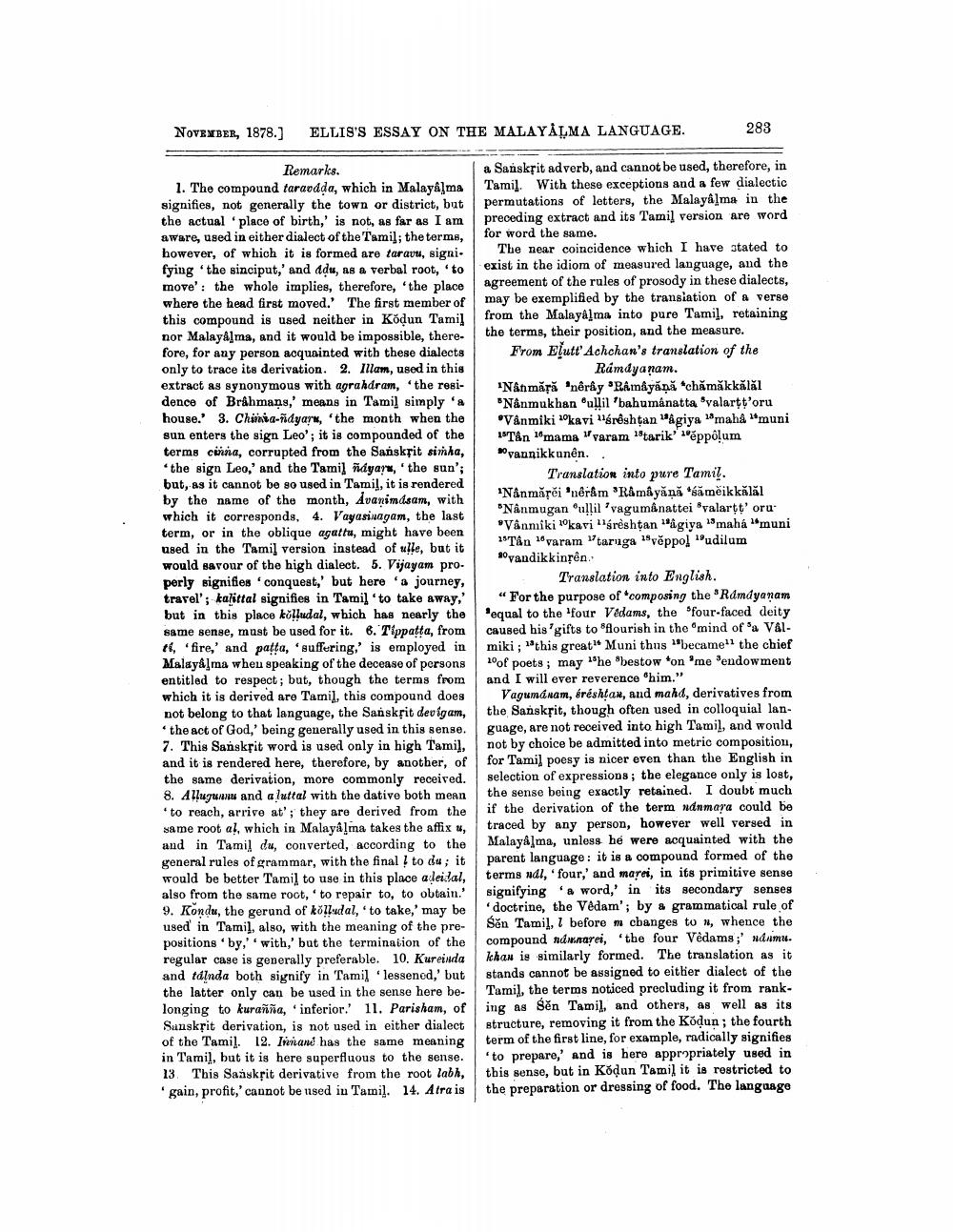________________
NOVEMBER, 1878.)
ELLIS'S ESSAY ON THE MALAYÅLMA LANGUAGE.
283
Remarks. 1. The compound taraodda, which in Malayalma signifies, not generally the town or district, but the actual place of birth,' is not, as far as I am aware, used in either dialect of the Tamil; the terms, however, of which it is formed are taravi, signi. fying 'the sinciput,' and adu, as a verbal root, 'to move': the whole implies, therefore, the place where the head first moved.' The first member of this compound is used neither in Ködun Tamil nor MalayAlma, and it would be impossible, there. fore, for any person acquainted with these dialects only to trace its derivation. 2. Mam, used in this extract as synonymous with agrahdram, the residence of Brahmans,' means in Tamil simply a house." 3. Chinnia-iidyars, the month when the sun enters the sign Leo'; it is compounded of the terms cina, corrupted from the Sanskrit simha, *the sign Leo,' and the Tamil ñdyar, 'the sun'; but, as it cannot be so used in Tamil, it is rendered by the name of the month, Avanimdsam, with which it corresponds. 4. Vayasinagam, the last term, or in the oblique agatta, might have been used in the Tamil version instead of sille, but it would savour of the high dialect. 5. Vijayam properly signifies conquest,' but here 'a journey, travel'; kalittal signifies in Tamil to take away,' but in this place kölludal, which has nearly the same sense, must be used for it. 6. Tippatta, from ti, 'fire,' and patta, suffering,' is employed in Malayalma when speaking of the decease of persons entitled to respect; but, though the terms from which it is derived are Tamil, this compound does not belong to that language, the Sanskrit devigam,
the act of God,' being generally used in this sense. 7. This Sanskrit word is used only in high Tamil, and it is rendered here, therefore, by another, of the same derivation, more commonly received. 8. Allugunnu and a luttal with the dative both mean 'to reach, arrive at'; they are derived from the same root al, which in Malayalma takes the affixu, and in Tamil du, converted, according to the general rules of grammar, with the final ! to du; it would be better Tamil to use in this place a leidal, also from the same root,' to repair to, to obtain.' 9. Kondu, the gerund of kollsdal, to take,' may be used' in Tamil, also, with the meaning of the prepositions by,'' with,' but the termination of the regular case is generally preferable. 10. Kureinda and tálnda both signify in Tamil lessenod,' but the latter only can be used in the sense here be- longing to kurañña, "inferior.' 11. Parisham, of Sanskrit derivation, is not used in either dinlect of the Tamil 12. Irenand has the same meaning in Tamil, but it is here superfluous to the sense. 13 This Sanskrit derivative from the root labh, 'gain, profit,' cannot be used in Tamil. 14. Atra is
a Sanskrit adverb, and cannot be used, therefore, in Tamil With these exceptions and a few dialectic permutations of letters, the Malayalma in the preceding extract and its Tamil version are word for word the same.
The near coincidence which I have stated to exist in the idiom of measured language, and the agreement of the rules of prosody in these dialects, may be exemplified by the translation of a verse from the Malayalma into pure Tamil, retaining the terms, their position, and the measure. From Elutt'Achchan's translation of the
Rámdyanam. Nân morõ “nêrây Bêmâyoại “chămăkkill *Nânmukhan Rullil 'bahumánatta valartt'oru "Vânmiki okavi uśrêshtan âgiya mahå *muni 1STân mama varam "Starik éppolum * vannikkunên
Translation into pure Tamil. INânmărči 'nêrâm "Råmâyănă "Să meikkălăl Nanmugan Rullil 'vagumânattei valartt'oru "Vânmiki kavi srèshtan agiya mahá "muni 20Tan varam taruga "Svěppol Pudilum svandikkinen
Translation into English. “For the purpose of composing the Ramayanam "equal to the 'four Vedams, the four-faced deity caused his 'gifts to flourish in the mind of 'a Valmiki; this great Muni thus became the chief 20of poets; may she bestow *on me 'endowment and I will ever reference him."
Vagundnam, éréshtax, and mahd, derivatives from the Sanskpit, though often used in colloquial language, are not received into high Tamil, and would not by choice be admitted into metric composition, for Tamil poesy is nicer even than the English in selection of expressions; the elegance only is lost, the sense being exactly retained. I doubt much if the derivation of the term ndnmaya could be traced by any person, however well versed in Malayalma, unless he were acquainted with the parent language: it is a compound formed of the terms udi, 'four,' and masei, in its primitive sense signifying a word,' in its secondary senses
doctrine, the Vedam'; by a grammatical rule of Śěn Tamil, 7 before m changes to , whence the compound ndunarei, 'the four Vēdams;' ndimu. khan is similarly formed. The translation as it stands cannot be assigned to either dialect of the Tamil, the terms noticed precluding it from ranking as sěn Tamil, and others, as well as its structure, removing it from the Kodun; the fourth term of the first line, for example, radically signifies
to prepare,' and is here appropriately used in this sense, but in Kodun Tamil it is restricted to the preparation or dressing of food. The language




